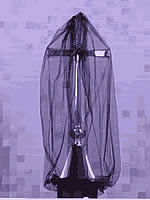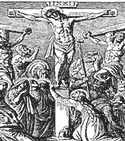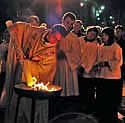 St Mary's Church, Dymock
St Mary's Church, Dymock
| Admin | |||
| . | Home | Contents | |
| H&S Policy | People Safety | Grave Yard | |
The Church & The World
Faith & Care
Faith & Care
Things Past
People & Features
People & Features
Seasons and Festivals

As well as the Seasons and Major Festivals, the church celebrates several 'Special Days' throughout the year to remember, honour or support our work in God's world. Celebration of the Special Days is usually optional, Christians chose which they want to include. Click here to view the 'Special Days'.

.
Lent reminds us of the fasting of Jesus in the wilderness (the desert) before he began his ministry. At that time, Jesus spent 40 days and 40 nights in personal reflection and prayer with God, working out who he was, what he had to do, and how he was going to do it. The season of Lent begins 46 days before Easter, copying Jesus' 40 days of fasting, but as that includes 6 Sundays - and Sundays are always 'feast' days - so Lent has to begin 46 days before Easter to provide 40 days of fasting.
.
During his time in the wilderness, Jesus had little to eat and was tempted to do spectacular things, such as turning stones into bread to eat, and throwing himself off the top of a tall building and floating gently down, which would have drawn attention to himself. His objective in coming to earth in human form was to draw attention to God, to explain God's purposes, and especially to make amends for human sin by obeying God perfectly. He realized that if he did the things he was tempted to do then he would be playing into the hands of the devil who tempts all humans and would not be obeying God, so he wouldn't be perfect, which would prevent him from achieving his objective (Matthew, chapter 4).
(Return to Top)

.
Austerity: It's usual to take out of the church all flowers and adornments. High churches (Anglican churches that copy parts of Roman Catholic practice), also wrap any crosses and statues depicting Jesus with a purple shroud, in deference to a passage in John's Gospel, in which Jesus hid himself from the authorities (John 8:59).
.
Self-reflection and fasting: This is similar to the self-reflection during the season of Advent and is a time for bringing to mind one's failure to keep God's Laws and being sorry for it. Lent especially has an emphasis on being sorry (penance); that is, on bringing to mind and being sorry for the things we do wrong (which we call 'sin').
.
Study: Many Christians attend a 'Lent Course' arranged locally or follow one of the many national courses that are published for that purpose, both as a penance (giving up time to study) and in order to learn more about God, about themselves, and about their own faith, thereby copying Jesus' time of learning about himself and what God wanted for him.
.
Fasting: This refers to abstaining from both food and festivities. Years ago it was common to abstain from food in more rigorous ways than we do today. People would go without food all day and not eat various foods at all during Lent, such as meat, eggs and alcohol - a vegetarian diet during Lent was not uncommon. Today most people in the west have relaxed those rules, but many still give up something as a sign of penance, such as chocolate, smoking, or alcohol. Many also refrain from going to parties or meetings in order to be symbolically alone, as Jesus was alone in the wilderness.


.
All churches celebrate this occasion with a special Service and Bible readings that recall the event. Some also begin with a procession to the church, waving palms or branches such as pampas grass, with or without a real donkey.
.
Palm Cross - many churches also give all attendees a cross made from palm leaves as a reminder of the event. The cross is usually kept at home until replaced the next year and can be burnt to create the ash for Ash Wednesday.
(Return to Top)

.
1. He gave thanks to God and then passed bread and wine around all the Apostles, part of the traditional Passover celebration. But he then introduced a new concept, by saying they represented his body and his blood and henceforth should be shared by all in remembrance of him - this is the origin of the most important Christian service of worship called 'Holy Communion', which most Christians celebrate regularly to this day. (Luke, chapter 22).
.
2. During the meal, Jesus took a towel and bowl of water and washed his Apostles' dusty feet, a task normally done by a slave or servant, By doing that Jesus demonstrated that even the greatest among us must serve others. As he did this, he said, 'A New Commandment I give you: love one other as I have loved you' (John, chapter 13). This is a good summary of the Laws given by God (The Ten Commandments) and remains the basis of the way Christians are required to live and behave towards each other and the rest of the world. On this day, many churches have a celebration of Holy Communion and a ceremonial washing of feet on this day to copy these two important events. (Return to Top)

.
When the Maundy Thursday Communion Service has ended, some churches continue by removing all the candle sticks, crosses, vases and cloths from the altar and sanctuary area of the church, leaving a bare altar table, although some leave a cross and unlit candles on the otherwise bare altar. After stripping the altar and sanctuary, in allusion to Jesus being stripped before he was tortured, people take it in turns to conduct a Vigil by watching in silence, praying or meditating by the altar for a period (eg: one hour) or even all night, in allusion to Jesus' request to his Disciples to 'watch for an hour'.
(Return to Top)

.
The customs associated with Good Friday are varied. Some churches hold a 'procession of witness' through the streets with someone carrying a full-size cross at the front, because Jesus carried his own cross to the place of execution. Others perform a play depicting the events of this day, often in the open air and attracting large crowds. Still others have a quiet and reflective Service in church with little or no music and no Communion, and yet others have a choral event of sombre music written about the day.

.
Some churches hold a Service this evening with a bonfire outside the church from which a candle is lit and carried in to the building as 'The Light of Christ' - For a fuller description, see Easter.
(Return to Top)
Customs Associated with Lent Include:

Pancakes
.
Traditionally, as part of the fasting, eggs were not eaten during Lent so they had to be used up before Lent began. Pancakes use a lot of eggs, so the traditional food on Shrove Tuesday includes pancakes - hence it's sometimes called 'pancake day'. It's the custom in some places to have a great celebration on this day before beginning the austerity of Lent, so in some places the day is known as Mardi Gras (literally 'Fat Tuesday') with feasting and a joyful carnival before starting the austerities of Lent. (Return to Top)